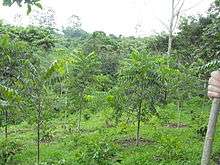Juglans olanchana
| Juglans olanchana | |
|---|---|
 | |
| Scientific classification | |
| Kingdom: | Plantae |
| (unranked): | Angiosperms |
| (unranked): | Eudicots |
| (unranked): | Rosids |
| Order: | Fagales |
| Family: | Juglandaceae |
| Genus: | Juglans |
| Species: | J. olanchana |
| Binomial name | |
| Juglans olanchana Standley & L.O. Williams | |
Juglans olanchana is a semideciduous tree up to 40 m in height and 1.5 m in diameter, which belongs to the Juglandaceae family. It is found in Costa Rica, Guatemala, El Salvador, Honduras, Mexico and Nicaragua.[1][2] It is commonly called cedro negro (Spanish for "Black Cedar" due to its close appearance to West Indian cedar) or nogal (Spanish for "walnut"). The long branches bear twigs tipped with 40–50 cm long, glabrous, pinately compound leaves, darker on the top than on the bottom. The base of the trunk sometimes has buttresses.
Habitat
Juglans olanchana grows in wet and very wet tropical forests, most frequently on river banks, observed from 0–1400 m above sea level. Reports that it also grows in the mountainous regions of Argentina may result from confusion with the cedro negro or nogal (J. neotropica)
Economic importance
Timber
J. olanchana has a cylindrical, straight shaft that is free of branches for 5–15 m. The moderately heavy (420–450 kg/m3) and moderately durable heartwood has a dark coffee color, is easy to work, and takes an excellent finish. It is used for light construction, cabinetmaking, parquet floors, luxurious furniture, turnery, musical instruments, and veneer.
Fruit
The nuts are edible. The husk is used to dye leather.
References
- ↑ "Tropicos | Name - Juglans olanchana Standl. & L.O. Williams". www.tropicos.org. Retrieved 2015-12-28.
- ↑ "Juglans olanchana". www.iucnredlist.org. Retrieved 2015-12-28.
